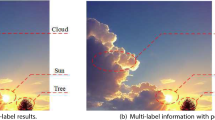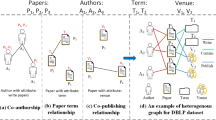Abstract
Graph learning is an important approach for machine learning. Kernel method is efficient for constructing similarity graph. Single kernel isn’t sufficient for complex problems. In this paper we propose a framework for multi-kernel learning. We give a brief introduction of Gaussian kernel, LLE and sparse representation. Then we analyze the advantages and disadvantages of these methods and give the reason why the combine of these methods with random walk is efficient. We compare our method with baseline methods on real-world data sets. The results show the efficiency of our method.








Similar content being viewed by others
References
Azran A, Ghahramani Z (2006) Spectral methods for automatic multiscale data clustering[C]. IEEE Computer Society Conference on Computer Vision and Pattern Recognition. IEEE. 1:190–197
Bach FR, Lanckriet GRG, Jordan MI (2004) Multiple kernel learning, conic duality, and the SMO algorithm[C]//proceedings of the twenty-first international conference on machine learning(ICML '04): 6-14
Belhumeur PN, Hespanha JP, Kriegman D (1997) Eigenfaces vs. fisherfaces: recognition using class specific linear projection. IEEE Trans Pattern Anal Mach Intell 19(7):711–720
Bengio Y, Delalleau O, Le Roux N (2006) Label propagation and quadratic criterion. Semi-Supervised Learning 10:1315–1634
Cheng B, Yang J, Yan S et al (2010) Learning with-graph for image analysis. IEEE Trans Image Process 19(4):858–866
Donoho D (2004) For most large underdetermined systems of linear equations the minimal l1-norm solution is also the sparsest solution. Commun Pure Appl Math 59(7):797C829
Gonen M, Alpaydin E (2011) Multiple kernel learning algorithms. J Mach Learn Res 12:2211–2268
Karasuyama M, Mamitsuka H (2013) Manifold-based similarity adaptation for label propagation[C]. Advances in Neural information processing systems(NIPS'13): 1547–1555
Kumar A, Daum H (2011) A co-training approach for multi-view spectral clustering [C]//Proceedings of the 28th International Conference on Machine Learning(ICML-11) 393–400
Kumar A, Rai P, Daume H (2011) Co-regularized multi-view spectral clustering[C]. Adv Neural Inf Process Syst (NIPS'11): 1413–1421
Liu J, Chen Y, Liu M et al (2011) SELM: semi-supervised ELM with application in sparse calibrated location estimation. Neurocomputing 74(16):2566–2572
Lov´asz L (1993) Random walks on graphs: a survey. Combinatorics, Paul Erdos is Eighty 2(1):1–46
Ng AY, Jordan MI, Weiss Y (2010) On spectral clustering: analysis and an algorithm. Adv Neural Inf Proces Syst 2002(2):849–856
Norris JR (1998) Markov chains[M]. Cambridge university press, Cambridge
Rakotomamonjy A, Bach F, Canu S et al (2008) Simple MKL. J Mach Learn Res 9:2491–2521
Shawe-Taylor N, Kandola A (2002) On kernel target alignment. Adv Neural Inf Proces Syst 14:367
Sonnenburg S, Ratsch G, Schafer C et al (2006) Large scale multiple kernel learning. J Mach Learn Res 7:1531–1565
Wang J, Yang J, Yu K et al (2010) Locality-constrained linear coding for image classification[C]. 2010 I.E. conference on computer vision and pattern recognition (CVPR’10), San Francisco, CA, 2010, pp. 3360–3367
Wold S, Esbensen K, Geladi P (1987) Principal component analysis. Chemom Intell Lab Syst 2(1):37–52
Wright J, Yang AY, Ganesh A et al (2009) Robust face recognition via sparse representation. IEEE Trans Pattern Anal Mach Intell 31(2):210–227
Yan S, Xu D, Zhang B et al (2007) Graph embedding and extensions: a general framework for dimensionality reduction. IEEE Trans Pattern Anal Mach Intell 29(1):40–51
Zhang X, You Q (2011) An improved spectral clustering algorithm based on random walk. Frontiers of Computer Science in China 5(3):268–278
Author information
Authors and Affiliations
Corresponding author
Rights and permissions
About this article
Cite this article
Sun, W., Pan, S. A random walk based multi-kernel graph learning framework. Multimed Tools Appl 77, 9943–9957 (2018). https://doi.org/10.1007/s11042-017-4599-8
Received:
Revised:
Accepted:
Published:
Issue Date:
DOI: https://doi.org/10.1007/s11042-017-4599-8




